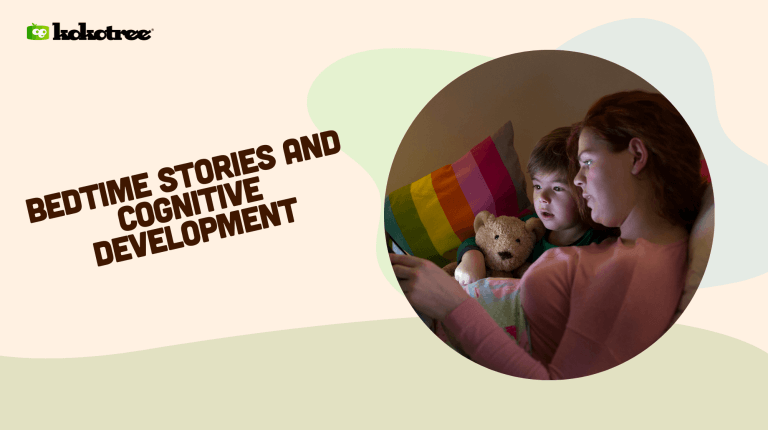

In the fascinating world of early childhood education, bedtime stories have long been recognized as a powerful tool for fostering a child’s cognitive development. Whether spun from the pages of a classic fairy tale or custom-tailored to your child’s unique interests, these nightly narratives can significantly impact language skills, brain development, and beyond.
Dive into this extensive exploration of the compelling benefits bedtime stories bring to the lives of young children as we unveil the marvels inherent in this time-honored tradition. Join us as we journey through the intricate ways in which storytelling at night can transform and elevate a child’s intellectual growth and emotional well-being.
Bedtime stories play a crucial role in children’s cognitive development by enhancing language skills, fostering creativity, and stimulating brain growth. The nurturing routine of sharing stories at night creates a solid foundation for literacy, strengthening vocabulary and comprehension abilities.
Additionally, these narratives help to develop problem-solving skills and emotional intelligence, as children empathize with characters and experience various situations vicariously. Bedtime stories contribute significantly to a child’s well-rounded intellectual and emotional development.
Every night, as parents and caregivers tuck their little ones into bed, they wield a powerful tool – bedtime stories. These enchanting tales passed down through generations or freshly concocted, possess the potential to transform a child’s cognitive development. Ready to dive into the intricate ways bedtime stories can enhance your child’s growth? I encourage you to continue reading for an exciting, information-packed journey through the world of bedtime storytelling.
One of the most immediate benefits of bedtime stories is the impact on a child’s vocabulary. As children listen to stories, they are exposed to new words and phrases, slowly expanding their vocabularies. The more diverse and rich the text, the greater the chances of language expansion. Even for children yet to understand narrative complexities, mere exposure to spoken words fosters a solid foundation for future language development.
Beyond vocabulary, listening to bedtime stories helps children develop crucial grammar and syntax skills. Children learn grammatical rules and sentence structure by hearing sentences structured in various forms. As they listen to stories, children can apply this knowledge in their speech, enabling them to express themselves more effectively.
Sharing bedtime stories with your child paves the way for improved reading skills. As they listen, children begin to recognize how the spoken word corresponds to written text, and this recognition gradually leads to early reading, comprehension, and, eventually, fluency. Following along with a story, focusing on punctuation and varying tones, enables children to grasp reading fundamentals and develop essential literacy skills.
Bedtime stories often present situations that require characters to navigate complex emotions and relationships. As children vicariously experience these struggles, they learn to empathize with the characters and develop an understanding of diverse perspectives. Through narrative journeys, children gain valuable insights into the minds and emotions of others, contributing to their emotional intelligence.
Infusing stories with varying emotions entertains and allows children to understand and express their emotions. By talking about the characters’ feelings, children become better equipped to identify, communicate, and manage their emotions, ultimately developing healthier relationships in the future.
Children embark on fantastical adventures during bedtime stories, from exploring far-off lands to befriending captivating creatures. The magical nature of these tales sparks curiosity and creativity, allowing children to envision worlds beyond their immediate surroundings. This imaginative exercise is essential for cognitive development, encouraging children to think abstractly and creatively.
Every enchanting bedtime story presents its share of challenges and obstacles for the characters. By following along, children engage with these difficulties, witnessing diverse problem-solving techniques. This exposure fosters critical thinking skills, providing children with the tools to tackle problems independently and creatively in their own lives.
As children listen to bedtime stories, they must remember plot points, characters, and settings to make sense of the narrative. This exercise in retaining and recalling information aids memory development, a vital cognitive skill. Regular storytelling sessions can improve memory capacity, enabling children to recall information quickly in different contexts.
Engaging bedtime stories capture children’s attention, drawing them into the narrative and encouraging them to remain focused. By practicing sustained attention during storytelling, children gradually develop improved focus and concentration, which will benefit their daily lives and educational pursuits.
The simple act of reading bedtime stories creates a unique bonding experience between parents and children. Sharing stories fosters a sense of security, nurtures valuable connections, and cultivates the parent-child relationship. With the hectic nature of modern life, carving out time to focus solely on each other becomes increasingly important in maintaining strong familial ties.
Sharing bedtime stories opens space for meaningful discussions about thoughts, feelings, and experiences. This environment of trust and open communication fosters a robust parent-child bond that extends far beyond the confines of the bedroom. Encouraging questions and conversations around story themes can lead to more profound connections and understanding of each other’s perspectives.
Selecting age-appropriate books ensures your child fully engages and benefits from the experience. Tailoring your choices to your child’s current interests, developmental stage, and comprehension abilities makes for a more enriching and enjoyable storytelling session.
Active participation during bedtime stories significantly enhances the experience. Engage your child by asking about the characters, plot, and feelings of specific events. Encourage them to share their predictions, fostering deeper connections and critical thinking skills.
Incorporating bedtime stories into your child’s nightly routine creates a sense of stability, comfort, and security in knowing what to expect. Consistently sharing stories allows your child to reap the full benefits of bedtime storytelling and fosters a love of reading.
Introducing a diverse range of stories keeps the experience fresh and expands your child’s exposure to different narrative styles, cultures, and themes. This broadened perspective can enhance their cognitive development and emotional intelligence.
Now that we’ve explored the wonders of bedtime stories, it’s time to embark on your storytelling adventure! As you enter this magical world, customize each experience to cater to your child’s unique interests and developmental stage. The immersive benefits of bedtime stories await, so grab a book and let the enchanting tales work their magic on your child’s cognitive development.
A conducive atmosphere enhances the magic of bedtime stories and helps children associate a positive emotional connection with reading and learning. Let’s explore simple ways to create a nurturing environment for bedtime story sessions to encourage cognitive development.
You can design a cozy space for storytime, whether a comfortable chair or a corner of your child’s bedroom. This dedicated reading nook allows total immersion in the storytelling experience while setting the stage for a relaxing bedtime routine.
Keeping distractions to a minimum during storytime helps children focus their attention on the tale at hand. Turn off electronic devices, lower the room’s lighting, and minimize background noise to create a calm, peaceful atmosphere conducive to story sharing and deep listening.
Integrating bedtime stories into your child’s nightly routine provides consistency and offers a sense of stability. Following a predictable timeline or sequence of activities each night creates a comforting environment that reinforces the value of reading and cognitive development.
Enhance your bedtime storytelling prowess by employing these interactive strategies to bring your stories to life, keeping your child captivated and fostering rich cognitive development.
Different tones, vocal inflections, and volume levels while reading add excitement and color to the story. Experimenting with various voices for other characters can make the tale more engaging, captivate your child’s attention, and create an immersive storytelling experience.
Bringing stories to life with animated facial expressions, hand gestures, and body language helps children visualize the narrative and enhances their understanding of the text. Embodying the characters’ emotions during storytelling makes the experience more dynamic and engaging.
Involve your child in the storytelling process by encouraging them to ask questions, discuss the characters and the plot, and make predictions about what may happen next. This interactive technique enhances their comprehension skills, fosters critical thinking, and deepens their emotional investment in the story.
As your child’s reading skills advance, consider taking turns reading sections of the story aloud. This collaborative approach to storytelling builds your child’s confidence and literacy skills and fosters a stronger connection between you and your child.
With a wealth of classic bedtime stories and contemporary releases available, selecting the perfect tales to share can feel overwhelming. Consider exploring a few cherished classics and modern gems for bedtime storytelling:
Embarking on bedtime story adventures with your child opens the door to a treasure trove of cognitive, emotional, and creative benefits. Delight in the magical world of storytelling and witness its transformative power for your child’s intellectual and emotional development.
Bedtime stories have long been cherished for their magical narratives and bonding opportunities, but they also offer children a wealth of cognitive benefits. Explore these Frequently Asked Questions to learn more about the impact of bedtime stories on your child’s development and gain some practical tips to enhance the storytelling experience.
It’s never too early to introduce your child to storytelling. Reading to your child from infancy can lay the foundation for language development and foster an early love of literature.
Ideally, reading should be incorporated into your child’s daily routine. Consistency is critical to ensuring that they fully benefit from the cognitive advantages that bedtime stories provide.
Choose books tailored to your child’s age, interests, and developmental stage. Opt for engaging, age-appropriate stories with captivating illustrations and varied themes to expand their perspectives.
Typically, 10 to 20 minutes is sufficient for a bedtime story session. Adjust the duration based on your child’s age, attention span, and needs.
Absolutely! Personalized stories can be even more engaging and add an extra connection layer. Develop customized narratives featuring your child’s favorite characters, settings, or experiences.
Yes, children often enjoy repetition as it provides comfort and familiarity. Repeated exposure to stories can strengthen language skills and foster an understanding of complex narratives.
Encourage your child to participate by asking questions, discussing the story or characters, and making predictions. You can also involve them in reading, using different voices, or mimicking actions.
Limit distractions by creating a comfortable space and turning off electronic devices. Experiment with various tones, expressions, and gestures to make the story more engaging.
While audiobooks offer some benefits but can’t replace the bonding experience and intimate connection during parent-child storytime, bedtime storytelling fosters a sense of security, nurtures relationships, and opens avenues for meaningful discussions.
Wordless picture books can promote cognitive development by encouraging imagination, storytelling, and critical thinking skills as children create their narratives based on the illustrations.
Select age-appropriate, engaging books, and read them with enthusiasm. Use different voices, expressions, and gestures to bring the story to life. Encourage your child to ask questions, discuss the story, and actively participate.
Bedtime stories expose children to various emotional situations, helping them empathize with characters and develop emotional intelligence. They also learn to recognize and express emotions more effectively in their own lives.
Consider exploring classics like “Goodnight Moon,” “Where the Wild Things Are,” and “The Very Hungry Caterpillar,” alongside modern gems such as “Ada Twist, Scientist,” “Press Here,” “The Pout-Pout Fish,” and “Giraffes Can’t Dance.”




